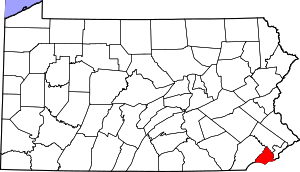Marcus Hook, Pennsylvania
Marcus Hook is a borough in Delaware County, Pennsylvania, United States. The population was 2,397 at the 2010 census.[3] The current mayor is Gene Taylor. The borough calls itself "The Cornerstone of Pennsylvania". The 2005 film One Last Thing... was set and partially filmed in Marcus Hook.
Marcus Hook, Pennsylvania Marreties Hoeck | |
|---|---|
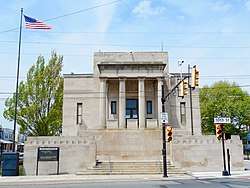 Borough Hall | |
| Motto(s): The Cornerstone of Pennsylvania | |
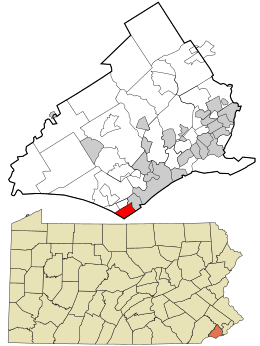 Location in Delaware County and the U.S. state of Pennsylvania. | |
 Marcus Hook Location of Marcus Hook in Pennsylvania  Marcus Hook Marcus Hook (the United States) | |
| Coordinates: 39°49′N 75°25′W | |
| Country | United States |
| State | Pennsylvania |
| County | Delaware |
| Established | 1655 |
| Government | |
| • Mayor | Gene Taylor |
| Area | |
| • Total | 1.62 sq mi (4.21 km2) |
| • Land | 1.11 sq mi (2.87 km2) |
| • Water | 0.52 sq mi (1.34 km2) |
| Elevation | 30 ft (9 m) |
| Population (2010) | |
| • Total | 2,397 |
| • Estimate (2018)[2] | 2,397 |
| • Density | 2,166.97/sq mi (836.42/km2) |
| Time zone | UTC-5 (EST) |
| • Summer (DST) | UTC-4 (EDT) |
| ZIP code | 19061 |
| Area code(s) | 610 and 484 |
| FIPS code | 42-47344 |
| Website | www |
History
The earliest inhabitants of Marcus Hook were the Lenape Indians and their indigenous ancestors, whose succeeding cultures had occupied this area for thousands of years.
The Lenape had a major settlement in Marcus Hook; New Sweden colonists established a trading post here in the 1640s. The village was called Chammassungh, or "Finland" by the Swedes. It was located on the west side of the Delaware River, between Marcus Hook Creek and Naamans Creek. Dutch colonists renamed the settlement as "Marrites Hoeck" after they conquered the area in 1655.[4] The name is derived from the word Hook, meaning promontory, or point of land projecting into the water and Marcus, a corruption of the name of the Indian chief, called Maarte by the Dutch, who lived at the Hook.[5]
English colonists gained control of the Dutch colonies and founded St. Martin's Church in 1699; the new church opened for worship in 1702. Walter Martin of Upper Chichester founded this church as an alternative place of worship and burial for Christian non-Quakers.[6]
Marcus Hook became a prosperous community and market town and in 1708 was of equal prominence to nearby Chester, Pennsylvania, with each location having approximately 100 houses.[7]
In the early 1700s, Marcus Hook was a haven for pirates who plagued the lower Delaware River. The market at Marcus Hook provided the pirates a place to sell plundered goods and re-supply away from the authorities and custom officials in Philadelphia. Early maps of Marcus Hook show the current Second Street was originally named "Discord Lane", since it was the location of the pirates' revelry when they were in town.[8]
According to a local oral tradition, the Marcus Hook Plank House was once the home of the mistress of the pirate Blackbeard.[8][9]
By the mid-1700s, Marcus Hook became a major regional center for the building of wooden sailing ships and remained so until the late 19th century. By that time, larger tonnage ships became more popular than the sloops and schooners built in Marcus Hook.[8]
During the American Revolutionary War, two tiers of underwater chevaux-de-frise obstacles were placed across the Delaware River at Marcus Hook to provide a first line of defense of Philadelphia against British naval forces.[10] Marcus Hook also served as a training center for the Pennsylvania militia. The Continental Army was stationed at Marcus Hook during the fall of 1777. As the town was bombarded by British warships more than once, there are very few pre-Revolutionary houses in Marcus Hook.[11]
Marcus Hook served as a defensive post along the Delaware River during the War of 1812, with over 5,000 United States troops placed there.[11]
The borough was officially incorporated on March 7, 1892. The convergence of rail, roads, a deepwater port, and the nation's growing thirst for petroleum gave rise to the refineries that became the borough's dominant industry.[12][13]
Sun Oil opened the Marcus Hook refinery in 1901 to refine crude oil brought by ship from Texas. It was the first of seven major refineries that made up the largest fuel-manufacturing center in the Northeast. The refinery was closed in 2011 due to deteriorating market conditions.[14]
In 1910, the American Viscose Corporation opened a plant in Marcus Hook for the production of rayon and other synthetic fibers.[15]
Geography
Marcus Hook is located along the southern border of Delaware County (and Pennsylvania) at 39°49′N 75°25′W (39.8182, -75.4155).[16] It is bordered to the northwest by Lower Chichester Township, including the community of Linwood, to the northeast by the borough of Trainer, to the southeast across the Delaware River by Gloucester County, New Jersey, and to the southwest by New Castle County, Delaware. The southern border of Marcus Hook is part of the Twelve-Mile Circle border between Pennsylvania and Delaware.
U.S. Route 13 (10th Street) is the main road through the borough, leading northeast 4 miles (6 km) to Chester, and southwest 9 miles (14 km) to Wilmington, Delaware. Pennsylvania Route 452 (Market Street) intersects US 13 in the center of the borough and leads north 1 mile (1.6 km) to Interstate 95 Exit 2, and 7 miles (11 km) to U.S. Route 1 west of Media.
According to the United States Census Bureau, Marcus Hook has a total area of 1.6 square miles (4.2 km2), of which 1.1 square miles (2.9 km2) is land and 0.50 square miles (1.3 km2), or 31.63%, is water.[3] The lowest point in the state of Pennsylvania is located on the Delaware River in Marcus Hook, where it flows out of Pennsylvania and into Delaware.
Educational system
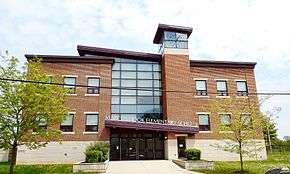
Marcus Hook is a part of Chichester School District. Children within the borough usually attend Marcus Hook Elementary School (Grades K-4), Chichester Middle School (Grades 5-8), or Chichester High School (Grades 9-12).
The area Catholic K-8 school is Holy Family Regional Catholic School in Aston. Marcus Hook previously had its own Catholic grade school, Immaculate Conception School. It closed in 1974, with students moved to Holy Savior School. That school merged into Holy Savior-St. John Fisher School in Linwood, which in turn merged into Holy Family in 2012.[17]
Demographics
| Historical population | |||
|---|---|---|---|
| Census | Pop. | %± | |
| 1900 | 1,209 | — | |
| 1910 | 1,573 | 30.1% | |
| 1920 | 5,324 | 238.5% | |
| 1930 | 4,867 | −8.6% | |
| 1940 | 4,123 | −15.3% | |
| 1950 | 3,843 | −6.8% | |
| 1960 | 3,299 | −14.2% | |
| 1970 | 3,041 | −7.8% | |
| 1980 | 2,638 | −13.3% | |
| 1990 | 2,546 | −3.5% | |
| 2000 | 2,314 | −9.1% | |
| 2010 | 2,397 | 3.6% | |
| Est. 2018 | 2,397 | [2] | 0.0% |
| Sources:[18][19][20] | |||
As of Census 2010, the racial makeup of the borough was 82.3% White, 13.6% African American, 0.1% Native American, 0.4% Asian, 0.3% from other races, and 3.6% from two or more races. Hispanic or Latino of any race were 3.0% of the population .
As of the census[19] of 2000, there were 2,314 people, 919 households, and 565 families residing in the borough. The population density was 2,055.7 people per square mile (790.7/km²). There were 1,025 housing units at an average density of 910.6 per square mile (350.2/km²). The racial makeup of the borough was 91.44% White, 5.32% African American, 0.09% Native American, 0.61% Asian, 0.69% from other races, and 1.86% from two or more races. Hispanic or Latino of any race were 1.77% of the population.
There were 919 households, out of which 32.1% had children under the age of 18 living with them, 33.9% were married couples living together, 19.8% had a female householder with no husband present, and 38.5% were non-families. 31.8% of all households were made up of individuals, and 12.3% had someone living alone who was 65 years of age or older. The average household size was 2.52 and the average family size was 3.18.
In the borough the population was spread out, with 28.1% under the age of 18, 8.9% from 18 to 24, 31.5% from 25 to 44, 20.4% from 45 to 64, and 11.1% who were 65 years of age or older. The median age was 34 years. For every 100 females, there were 94.1 males. For every 100 females age 18 and over, there were 90.4 males.
The median income for a household in the borough was $28,219, and the median income for a family was $36,083. Males had a median income of $31,620 versus $24,569 for females. The per capita income for the borough was $13,738. About 13.3% of families and 21.7% of the population were below the poverty line, including 22.5% of those under age 18 and 16.5% of those age 65 or over.
Transportation
Marcus Hook Station is a SEPTA train station on the Wilmington/Newark Line.
Notable people

_flickr.jpg)
- Ron Bennington, Sirius Radio personality
- William Bucknell, businessman and benefactor of Bucknell University
- Elisha Cullen Dick, born at Blue Ball Inn, attending physician of George Washington at time of his death
- Ralph Garzia, member of the Pennsylvania House of Representatives, 160th district
- John Grubb, member of the Pennsylvania Provincial Assembly and original settler of Brandywine Hundred, buried at St. Martins Church
- Robert E. Haebel, United States Marine Corps major general
- Billy "White Shoes" Johnson, NFL player
- Albert Dutton MacDade, Pennsylvania State Senator and Judge in the Delaware County Court of Common Pleas
- Mickey Vernon, Major League Baseball player
- Curt Weldon, former congressman from Pennsylvania and former mayor of Marcus Hook
Local community groups
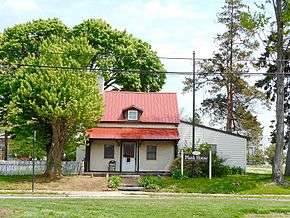

In the interest of protecting and remembering nearly 400 years of history in Marcus Hook two groups were created. The Marcus Hook Preservation Society works with the community, local universities and archeology groups to fund archeological digs and set up educational programs. The Plankhouse Crew is a pirate reenactment group focusing on the Golden Age of Piracy and provides living history demonstrations as well as entertainment. The Plankhouse Crew was created around the Plankhouse which was believed to be the former home of a woman named Margaret, a mistress of the infamous pirate Blackbeard. They are also Marcus Hook's featured group for the annual Delaware River River Ramble celebration held in September.
Religion
The Roman Catholic Archdiocese of Philadelphia operates Catholic churches. Immaculate Conception of Lourdes Church in Marcus Hook opened in January 1917.[21] In 2013 Immaculate Conception merged with in St. John Fisher Church in Upper Chichester Township, with the Immaculate Conception parish closed.[22]
References in popular culture
The 2005 American comedy-drama film One Last Thing..., about a sixteen year old terminally ill boy hoping his final wish is granted, takes place in Marcus Hook.[23]
References
- "2017 U.S. Gazetteer Files". United States Census Bureau. Retrieved Mar 24, 2019.
- "Population and Housing Unit Estimates". Retrieved December 15, 2019.
- "Geographic Identifiers: 2010 Demographic Profile Data (G001): Marcus Hook borough, Pennsylvania". U.S. Census Bureau, American Factfinder. Archived from the original on February 13, 2020. Retrieved December 28, 2015.
- "History". www.marcushookps.org. Retrieved 8 December 2017.
- Martin, John Hill (1877). Chester (and its Vicinity,) Delaware County, in Pennsylvania. Philadelphia: Wm. H. Pile & Sons. p. 67. Retrieved 9 January 2018.
- "St. Martins Church". www.chichesterhistory.org. Retrieved 8 December 2017.
- Ashmead, Henry Graham (1884). A History of Delaware County, Pennsylvania. Philadelphia: L.H. Everts & Co. p. 456. Retrieved 17 December 2017.
- "The Plank House". www.marcushookps.org. Retrieved 17 December 2017.
- Ashmead, Henry Graham (1884). A History of Delaware County, Pennsylvania. Philadelphia: L.H. Everts & Co. pp. 457–458. Retrieved 20 December 2017.
- Martin, John Hill (1877). Chester (and Its Vicinity,) Delaware County, in Pennsylvania. Philadelphia: Wm. H. Pile & Sons. p. 175. Retrieved 12 January 2018.
- "The Plank House". www.marcushookps.org. Retrieved 31 December 2017.
- Myers, Albert Cook, ed. (1912). Narratives of Early Pennsylvania, West New Jersey and Delaware. 1630-1707. New York: Charles Scribner's Sons. OCLC 650030300. Retrieved September 25, 2010.
- "THE BOROUGH OF MARCUS HOOK". March 5, 2010. Retrieved September 25, 2010.
- Maykuth, Andrew. "Sunoco abruptly shuts Marcus Hook refinery". www.philly.com. Retrieved 15 April 2018.
- Wilkins, Mira (2004). The History of Foreign Investment in the United States, 1914-1945. Cambridge, Mass: Harvard University Press. p. 152. ISBN 0674045181. Retrieved 1 May 2018.
- "US Gazetteer files: 2010, 2000, and 1990". United States Census Bureau. 2011-02-12. Retrieved 2011-04-23.
- Rodgers, Loretta (2012-06-04). "Alumni offer final farewells to Holy Saviour-St. John Fisher School". Delco Times. Retrieved 2020-05-03.
- "Census of Population and Housing". U.S. Census Bureau. Retrieved 11 December 2013.
- "U.S. Census website". United States Census Bureau. Retrieved 2008-01-31.
- "Incorporated Places and Minor Civil Divisions Datasets: Subcounty Resident Population Estimates: April 1, 2010 to July 1, 2012". Population Estimates. U.S. Census Bureau. Archived from the original on 11 June 2013. Retrieved 11 December 2013.
- "Immaculate Conception (Italian)". Roman Catholic Archdiocese of Philadelphia. 2008-11-21. Retrieved 2020-05-03.
- Mengers, Patti (2013-06-30). "5 Delco parishes lament closures". Delco Times. Retrieved 2020-05-03.
- "One Last Thing... (2005)". www.imdb.com. Retrieved 15 April 2018.
External links

- Borough of Marcus Hook official website
- Marcus Hook Preservation Society
- The Plankhouse Crew
